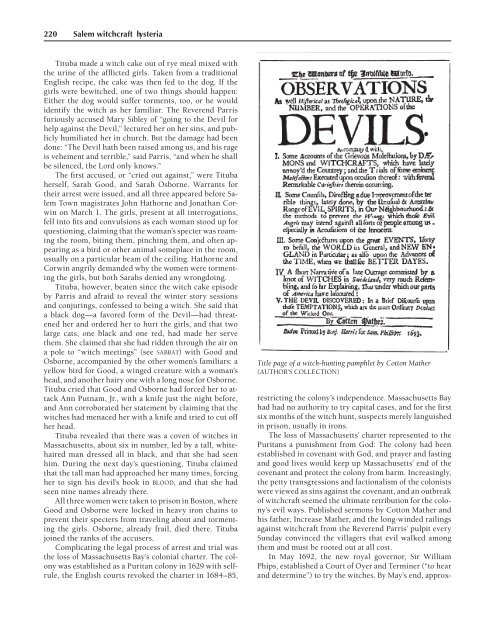The Encyclopedia Of Demons And Demonology
The Encyclopedia Of Demons And Demonology
The Encyclopedia Of Demons And Demonology
You also want an ePaper? Increase the reach of your titles
YUMPU automatically turns print PDFs into web optimized ePapers that Google loves.
220 Salem witchcraft hysteria<br />
Tituba made a witch cake out of rye meal mixed with<br />
the urine of the afflicted girls. Taken from a traditional<br />
English recipe, the cake was then fed to the dog. If the<br />
girls were bewitched, one of two things should happen:<br />
Either the dog would suffer torments, too, or he would<br />
identify the witch as her familiar. <strong>The</strong> Reverend Parris<br />
furiously accused Mary Sibley of “going to the Devil for<br />
help against the Devil,” lectured her on her sins, and publicly<br />
humiliated her in church. But the damage had been<br />
done: “<strong>The</strong> Devil hath been raised among us, and his rage<br />
is vehement and terrible,” said Parris, “and when he shall<br />
be silenced, the Lord only knows.”<br />
<strong>The</strong> first accused, or “cried out against,” were Tituba<br />
herself, Sarah Good, and Sarah Osborne. Warrants for<br />
their arrest were issued, and all three appeared before Salem<br />
Town magistrates John Hathorne and Jonathan Corwin<br />
on March 1. <strong>The</strong> girls, present at all interrogations,<br />
fell into fits and convulsions as each woman stood up for<br />
questioning, claiming that the woman’s specter was roaming<br />
the room, biting them, pinching them, and often appearing<br />
as a bird or other animal someplace in the room,<br />
usually on a particular beam of the ceiling. Hathorne and<br />
Corwin angrily demanded why the women were tormenting<br />
the girls, but both Sarahs denied any wrongdoing.<br />
Tituba, however, beaten since the witch cake episode<br />
by Parris and afraid to reveal the winter story sessions<br />
and conjurings, confessed to being a witch. She said that<br />
a black dog—a favored form of the Devil—had threatened<br />
her and ordered her to hurt the girls, and that two<br />
large cats, one black and one red, had made her serve<br />
them. She claimed that she had ridden through the air on<br />
a pole to “witch meetings” (see SABBAT) with Good and<br />
Osborne, accompanied by the other women’s familiars: a<br />
yellow bird for Good, a winged creature with a woman’s<br />
head, and another hairy one with a long nose for Osborne.<br />
Tituba cried that Good and Osborne had forced her to attack<br />
Ann Putnam, Jr., with a knife just the night before,<br />
and Ann corroborated her statement by claiming that the<br />
witches had menaced her with a knife and tried to cut off<br />
her head.<br />
Tituba revealed that there was a coven of witches in<br />
Massachusetts, about six in number, led by a tall, whitehaired<br />
man dressed all in black, and that she had seen<br />
him. During the next day’s questioning, Tituba claimed<br />
that the tall man had approached her many times, forcing<br />
her to sign his devil’s book in BLOOD, and that she had<br />
seen nine names already there.<br />
All three women were taken to prison in Boston, where<br />
Good and Osborne were locked in heavy iron chains to<br />
prevent their specters from traveling about and tormenting<br />
the girls. Osborne, already frail, died there. Tituba<br />
joined the ranks of the accusers.<br />
Complicating the legal process of arrest and trial was<br />
the loss of Massachusetts Bay’s colonial charter. <strong>The</strong> colony<br />
was established as a Puritan colony in 1629 with selfrule,<br />
the English courts revoked the charter in 1684–85,<br />
Title page of a witch-hunting pamphlet by Cotton Mather<br />
(AUTHOR’S COLLECTION)<br />
restricting the colony’s independence. Massachusetts Bay<br />
had had no authority to try capital cases, and for the first<br />
six months of the witch hunt, suspects merely languished<br />
in prison, usually in irons.<br />
<strong>The</strong> loss of Massachusetts’ charter represented to the<br />
Puritans a punishment from God: <strong>The</strong> colony had been<br />
established in covenant with God, and prayer and fasting<br />
and good lives would keep up Massachusetts’ end of the<br />
covenant and protect the colony from harm. Increasingly,<br />
the petty transgressions and factionalism of the colonists<br />
were viewed as sins against the covenant, and an outbreak<br />
of witchcraft seemed the ultimate retribution for the colony’s<br />
evil ways. Published sermons by Cotton Mather and<br />
his father, Increase Mather, and the long-winded railings<br />
against witchcraft from the Reverend Parris’ pulpit every<br />
Sunday convinced the villagers that evil walked among<br />
them and must be rooted out at all cost.<br />
In May 1692, the new royal governor, Sir William<br />
Phips, established a Court of Oyer and Terminer (“to hear<br />
and determine”) to try the witches. By May’s end, approx-












